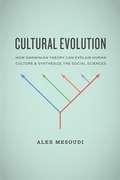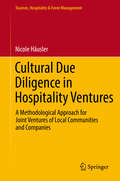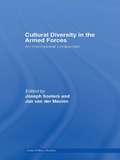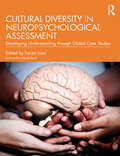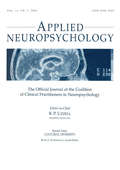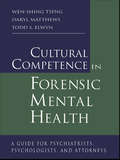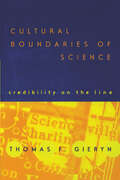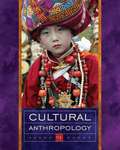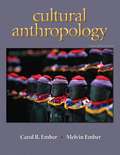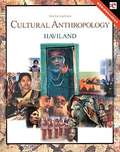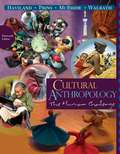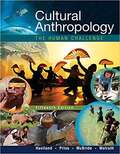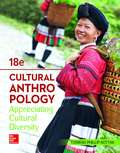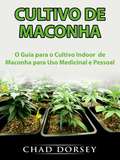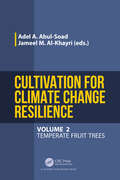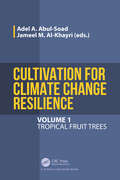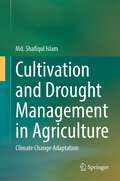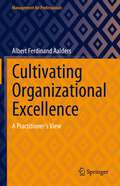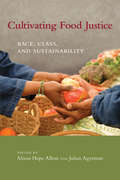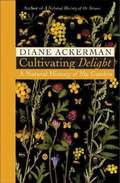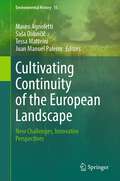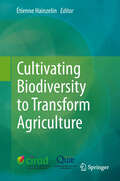- Table View
- List View
Cultural Evolution: How Darwinian Theory Can Explain Human Culture And Synthesize The Social Sciences
by Alex MesoudiCharles Darwin changed the course of scientific thinking by showing how evolution accounts for the stunning diversity and biological complexity of life on earth. Recently, there has also been increased interest in the social sciences in how Darwinian theory can explain human culture. Covering a wide range of topics, including fads, public policy, the spread of religion, and herd behavior in markets, Alex Mesoudi shows that human culture is itself an evolutionary process that exhibits the key Darwinian mechanisms of variation, competition, and inheritance. This cross-disciplinary volume focuses on the ways cultural phenomena can be studied scientifically-from theoretical modeling to lab experiments, archaeological fieldwork to ethnographic studies-and shows how apparently disparate methods can complement one another to the mutual benefit of the various social science disciplines. Along the way, the book reveals how new insights arise from looking at culture from an evolutionary angle. Cultural Evolutionprovides a thought-provoking argument that Darwinian evolutionary theory can both unify different branches of inquiry and enhance understanding of human behavior.
Cultural Due Diligence in Hospitality Ventures
by Nicole HäuslerThis book introduces readers to a powerful method for cross-cultural due diligence in mergers and organizational collaborations. It employs the context of joint ventures between local communities and companies in the domain of hospitality in emerging tourism destinations. The book first analyzes the impact of cultural diversity in mergers between local communities and the private sector, revealing the characteristics and functions of culture and paying specific attention to the roles of organizational and community cultures in hospitality. In two subsequent methodological chapters the book presents a theoretical framework for cultural due diligence and identifies the principal actors, technical aspects and core principles. On the basis of a separate case study from northern Thailand, the book provides an example of cultural context analysis and presents the findings and results. In a concluding chapter the book presents an outlook on further research and development in this field.
Cultural Diversity in the Armed Forces: An International Comparison (Cass Military Studies)
by Joseph Soeters Jan van der MeulenThis volume explores ethnicity and gender developments in relation to the military. In some countries, the armed forces have a long history in responding to ethnic diversity, while elsewhere it has come up only recently as a policy issue. An even-handed representation of ethnic minorities in the military is recognized as crucial for enhancing its social legitimacy and professional quality. The same can be said about the integration of women in the military, which during a few decades across the board has grown into more than just another issue of personnel policies. Indeed with regard to gender, the symbolism and sensitivities surrounding core identities are at stake – as with the presence of gays and lesbians in the military. Written by experts in the field, the chapters cover fourteen countries around the world: the USA, Canada, Bolivia, Ecuador, Brazil, South-Africa, Eritrea, India, Israel, Great Britain, France, Germany, Belgium and The Netherlands. Taken together, the armed forces of these countries offer a fascinating mix of similarities and differences in the ways they try to manage cultural diversity. Cultural Diversity in the Armed Forces will be of interest to students and scholars of military studies, sociology, gender and political science.
Cultural Diversity in Neuropsychological Assessment: Developing Understanding through Global Case Studies
by Farzin IraniCultural Diversity in Neuropsychological Assessment provides a platform for clinical neuropsychologists, psychologists, and trainees to bridge cultures and speak to each other about the ethnically diverse communities they serve throughout the world. It allows readers to peek into their clinical filing cabinets and examine how they worked with diverse individuals from indigenous and migrant communities of Arab, Asian, European, Israeli, Latin American and Caribbean, Persian, Russian, Sub-Saharan African, and North American origin. The book first reviews important foundations for working with diverse communities that include key knowledge, awareness, skills, and action orientation. It then provides a collection of cases for each cultural geographic region. Each section begins with an introductory chapter to provide a bird’s eye view of the historical and current state of clinical and research practice of neuropsychology in that region. Then, each chapter focuses on a specific community by providing surface and deep-level cultural background knowledge from the authors’ unique perspectives. A case study is then covered in depth to practically showcase an evaluation with someone from that community. This is followed by a summary of key strategic points, lessons learned, references, further readings, and a glossary of culture specific terminology used throughout the chapter. In the end, the appendix provides a list of culturally relevant tests and norms for some communities. This ground-breaking peer-reviewed handbook provides an invaluable clinical resource for neuropsychologists, psychologists, and trainees. It increases self-reflection about multicultural awareness and knowledge, highlights practical ways to increase cultural understanding in neuropsychological and psychological assessments, and sparks further discussion for professional and personal growth in this area.
Cultural Diversity: A Special Issue of applied Neuropsychology
by B. P. UzzellCultural Diversity studies the relationship between culture and neuropsychology. Its goal is to examine salient aspects of this relationship and assist in bringing the issue of culture and cultural diversity to the forefront of neuropsychological discussions. The articles help further the understanding that ethnic and cultural variables are important not only in research design but also in clinical practice. In addition they urge clinicians to make cultural variables an integral component of any neuropsychological assessment and examine clinical data in the context of the patient's ethnic and cultural backround.
Cultural Competence in Forensic Mental Health: A Guide for Psychiatrists, Psychologists, and Attorneys
by Wen-Shing Tseng Daryl Matthews Todd S. ElwynAs culturally relevant psychiatry becomes common practice, the need for competent and culturally relevant forensic psychiatry comes to the forefront. This volume, written by one expert in cultural psychiatry and another in forensic psychiatry addresses that need. By combining their expertise in these areas, they are able to develop and create a new body of knowledge and experiences addressing the issue of the cultural aspects of forensic psychiatry. Beginning with an introduction to cultural and ethnic aspects of forensic psychiatry, this volume will address basic issues of the practice, as well as more detailed areas ranging from the various psychiatric disorders to intensive analysis and discussion of how to perform forensic psychiatric practice in a culturally relevant and competent way. Also the book suggests methods for continued awareness and sensitivity to issues of cultural and ethnic diversity in the field.
Cultural Boundaries of Science: Credibility on the Line
by Thomas F. GierynWhy is science so credible? Usual answers center on scientists' objective methods or their powerful instruments. In his new book, Thomas Gieryn argues that a better explanation for the cultural authority of science lies downstream, when scientific claims leave laboratories and enter courtrooms, boardrooms, and living rooms. On such occasions, we use "maps" to decide who to believe—cultural maps demarcating "science" from pseudoscience, ideology, faith, or nonsense. Gieryn looks at episodes of boundary-work: Was phrenology good science? How about cold fusion? Is social science really scientific? Is organic farming? After centuries of disputes like these, Gieryn finds no stable criteria that absolutely distinguish science from non-science. Science remains a pliable cultural space, flexibly reshaped to claim credibility for some beliefs while denying it to others. In a timely epilogue, Gieryn finds this same controversy at the heart of the raging "science wars."
Cultural Boundaries of Science: Credibility on the Line
by Thomas F. GierynWhy is science so credible? Usual answers center on scientists' objective methods or their powerful instruments. In his new book, Thomas Gieryn argues that a better explanation for the cultural authority of science lies downstream, when scientific claims leave laboratories and enter courtrooms, boardrooms, and living rooms. On such occasions, we use "maps" to decide who to believe—cultural maps demarcating "science" from pseudoscience, ideology, faith, or nonsense. Gieryn looks at episodes of boundary-work: Was phrenology good science? How about cold fusion? Is social science really scientific? Is organic farming? After centuries of disputes like these, Gieryn finds no stable criteria that absolutely distinguish science from non-science. Science remains a pliable cultural space, flexibly reshaped to claim credibility for some beliefs while denying it to others. In a timely epilogue, Gieryn finds this same controversy at the heart of the raging "science wars."
Cultural Boundaries of Science: Credibility on the Line
by Thomas F. GierynWhy is science so credible? Usual answers center on scientists' objective methods or their powerful instruments. In his new book, Thomas Gieryn argues that a better explanation for the cultural authority of science lies downstream, when scientific claims leave laboratories and enter courtrooms, boardrooms, and living rooms. On such occasions, we use "maps" to decide who to believe—cultural maps demarcating "science" from pseudoscience, ideology, faith, or nonsense. Gieryn looks at episodes of boundary-work: Was phrenology good science? How about cold fusion? Is social science really scientific? Is organic farming? After centuries of disputes like these, Gieryn finds no stable criteria that absolutely distinguish science from non-science. Science remains a pliable cultural space, flexibly reshaped to claim credibility for some beliefs while denying it to others. In a timely epilogue, Gieryn finds this same controversy at the heart of the raging "science wars."
Cultural Anthropology (9th edition)
by Serena Nanda Richard L. WarmsThis book continues to bring you excellent coverage of cultures from around the world. The text also continues to emphasize issues of gender, stratification, ethnicity, globalization, and contemporary issues.
Cultural Anthropology
by Carol R. Ember Melvin R. EmberCultural Anthropology,provides both a comprehensive and scientific introduction to cultural anthropology. It helps the reader understand how humans vary culturally and why they got to be that way. This new edition also highlights migration and immigration in the context of globalization.
Cultural Anthropology
by William A. HavilandCultural Anthropology is designed for introductory anthropology courses at the college level.
Cultural Anthropology: The Human Challenge
by William A. Haviland Harald E. L. Prins Bunny McbrideExplore the most fascinating, creative, dangerous, and complex species alive today: you and your neighbors in the global village. With compelling photos, engaging examples, and select studies by anthropologists in far-flung places, the authors of CULTURAL ANTHROPOLOGY: THE HUMAN CHALLENGE provide a holistic view of anthropology to help you make sense of today's world. With this text you will discover the different ways humans face the challenge of existence, the connection between biology and culture in the shaping of human beliefs and behavior, and the impact of globalization on peoples and cultures around the world.
Cultural Anthropology: The Human Challenge (Mindtap Course List Series)
by William A. Haviland Harald E. L. Prins WalrathExplore the most fascinating, creative, dangerous, and complex species alive today: you and your neighbors in the global village. With compelling photos, engaging examples, and select studies by anthropologists in far-flung places, the authors of CULTURAL ANTHROPOLOGY: THE HUMAN CHALLENGE, 15th Edition, provide a holistic view of anthropology to help you make sense of today's world. <p><p> With this text, you will discover the different ways humans face the challenge of existence, the connection between biology and culture in the shaping of human beliefs and behavior, and the impact of globalization on peoples and cultures around the world. It comes with MindTap, a digital interactive learning platform with an array of tools and apps from video clips to notetaking and flashcards, which will enliven your study and help you achieve better grades.
Cultural Anthropology: Appreciating Cultural Diversity
by Conrad Phillip KottakCultural Anthropology offers an up-to-date holistic introduction to anthropology from the four-field perspective. Key themes of appreciating the experiences students bring to the classroom, appreciating human diversity, and appreciating the field of anthropology are showcased throughout the text. The program presents anthropology’s core concepts and also demonstrates anthropology’s relevance to the 21st-century world we inhabit. Revisions to the 18th edition of Cultural Anthropology were extensively informed by student data, collected anonymously by McGraw-Hill’s adaptive learning system. Connect is the integrated learning system that empowers students by continuously adapting to deliver precisely what they need, when they need it, and how they need it, so that your class time is more engaging and effective.
Cultivo de Maconha: O Guia para o Cultivo Indoor de Maconha para Uso Medicinal e Pessoal
by Hiddenstuff EntertainmentO melhor livro de referência e guia passo a passo para o cultivo de maconha. Aprenda a culivar cannabis seguindo instruções passo a passo. Aprenda e comece a cultivar em apenas algumas horas. Você irá produzir como um profissional usando as estratégias de cultivo mais efetivas. Inclui: -Projetando o seu Espaço de Cultivo -Iluminação -Ventilação -Como Monitorá-la -Ambientes de Cultivo -Recipientes -Nutrientes -Regando suas Plantas Economize tempo e dinheiro usando este super guia. --> Suba ao topo da página e adicione ao carrinho para comprar instantaneamente Aviso: O autor e/ou proprietário dos direitos autorais não faz afirmações, promessas ou garantias quanto a eficácia, completude ou adequação dos conteúdos deste livo e isenta-se de responsabilidade quanto a qualquer erro ou omissão de seu conteúdo. Este produto deve ser usado apenas como referência.
Cultivation for Climate Change Resilience, Volume 2: Temperate Fruit Trees
by Adel A. Abul-Soad Jarneel M. Al-KhayriThis book focuses on various tropical fruit tree species management for climate change including mitigation strategies and technological countermeasures taken by researchers, progressive growers and commercial companies to overcome the adverse changes. It can be considered as a unique source emphasizing the fruit species solitary not by subject as usual to enable readers reaching directly to their crop of interest. The content includes genetic resources conservation, remote sensing and environmental certification. Increasing attention of society toward information and measures taken by various stakeholders about climate change risks and threats makes this book very timely. Key points • Provides a contemporary view of the impact of climate change on cultivation of individual fruit species. • Offers modern approaches for mitigating the adverse impact of climate change on fruits cultivation. • Describes research progress of understanding and combating the impact of climate change on fruits production. • Illustrates presented concepts with relevant figures and tabulated data.
Cultivation for Climate Change Resilience, Volume 1: Tropical Fruit Trees
by Adel A. Abul-Soad Jameel M. Al-KhayriThis book focuses on various tropical fruit tree species management for climate change including mitigation strategies and technological countermeasures taken by researchers, progressive growers and commercial companies to overcome the adverse changes. It can be considered as a unique source emphasizing the fruit species solitary not by subject as usual to enable readers reaching directly to their crop of interest. The content includes genetic resources conservation, remote sensing and environmental certification. Increasing attention of the society toward information and measures taken by various stakeholders about climate change risks and threats makes this book very timely. Key points covered: Provides a contemporary view of the impact of climate change on cultivation of individual fruit species Offers modern approaches for mitigating the adverse impact of climate change on fruits cultivation Describes research progress of understanding and combating the impact of climate change on fruits production Illustrates presented concepts with relevant figures and tabulated data
Cultivation and Drought Management in Agriculture: Climate Change Adaptation
by Md. Shafiqul IslamThis book represents the background of the Barind Tract of Bangladesh with the proximity of drought information, conceptual and logic of the books, history, definition and perception on drought and climate scenario and how people understand underlying causes, impacts and consequences of drought in agriculture, environment, human health and society. It also states the trend and severity of drought of Barind Tract. This book gives the local response to cope, mitigation and adaptation to agricultural drought. The book also addresses the gender response in the hardship of drought in the rural areas. It also elicits the local and indigenous methods of drought prediction and sustainable cultivation and management of drought in agriculture.
Cultivating Organizational Excellence: A Practitioner’s View (Management for Professionals)
by Albert Ferdinand AaldersThis book offers a comprehensive approach to organizational excellence based on the author’s vast experience in managing excellence at highly innovative and dynamic organizations. It integrates various approaches into a consistent view of achieving excellence in the context of dynamic technological and societal developments. Starting from purpose and mission, it describes stakeholder mapping and analysis, and process and quality management. In turn, it sheds light on how to deal with business dynamics of various types and demonstrates how quantum-mechanical models can help to understand and manage dynamic organizational processes. The book then introduces readers to result measuring and performance management, followed by organizational learning and rewards and recognition. Moreover, it discusses (innovation) ecosystem leverage and organizational culture management as further important capabilities of excellent organizations. Best practices in corporate social responsibility and environmental, social and governance aspects are fully integrated throughout the book, which concludes by explaining how the UN Sustainable Development Goals can be applied to optimize business initiatives. The book is intended as a source of inspiration for managers working under highly dynamic organizational conditions, helping them take their businesses to higher levels. It also provides valuable industrial insights for scholars with an interest in organizational excellence.
Cultivating Food Justice: Race, Class, and Sustainability (Food, Health, and the Environment)
by Alison Hope Alkon Julian AgyemanDocuments how racial and social inequalities are built into our food system, and how communities are creating environmentally sustainable and socially just alternatives.Popularized by such best-selling authors as Michael Pollan, Barbara Kingsolver, and Eric Schlosser, a growing food movement urges us to support sustainable agriculture by eating fresh food produced on local family farms. But many low-income neighborhoods and communities of color have been systematically deprived of access to healthy and sustainable food. These communities have been actively prevented from producing their own food and often live in “food deserts” where fast food is more common than fresh food. Cultivating Food Justice describes their efforts to envision and create environmentally sustainable and socially just alternatives to the food system. Bringing together insights from studies of environmental justice, sustainable agriculture, critical race theory, and food studies, Cultivating Food Justice highlights the ways race and class inequalities permeate the food system, from production to distribution to consumption. The studies offered in the book explore a range of important issues, including agricultural and land use policies that systematically disadvantage Native American, African American, Latino/a, and Asian American farmers and farmworkers; access problems in both urban and rural areas; efforts to create sustainable local food systems in low-income communities of color; and future directions for the food justice movement. These diverse accounts of the relationships among food, environmentalism, justice, race, and identity will help guide efforts to achieve a just and sustainable agriculture.
Cultivating Food Justice
by Alison Hope Alkon Julian AgyemanPopularized by such best-selling authors as Michael Pollan, Barbara Kingsolver, and Eric Schlosser, a growing food movement urges us to support sustainable agriculture by eating fresh food produced on local family farms. But many low-income neighborhoods and communities of color have been systematically deprived of access to healthy and sustainable food. These communities have been actively prevented from producing their own food and often live in "food deserts" where fast food is more common than fresh food. Cultivating Food Justice describes their efforts to envision and create environmentally sustainable and socially just alternatives to the food system. Bringing together insights from studies of environmental justice, sustainable agriculture, critical race theory, and food studies, Cultivating Food Justice highlights the ways race and class inequalities permeate the food system, from production to distribution to consumption. The studies offered in the book explore a range of important issues, including agricultural and land use policies that systematically disadvantage Native American, African American, Latino/a, and Asian American farmers and farmworkers; access problems in both urban and rural areas; efforts to create sustainable local food systems in low-income communities of color; and future directions for the food justice movement. These diverse accounts of the relationships among food, environmentalism, justice, race, and identity will help guide efforts to achieve a just and sustainable agriculture.
Cultivating Delight: A Natural History of My Garden
by Diane Ackerman"Cultivating Delight" celebrates the sensory pleasures that the author discovers in her garden.
Cultivating Continuity of the European Landscape: New Challenges, Innovative Perspectives (Environmental History #15)
by Mauro Agnoletti Saša Dobričič Tessa Matteini Juan Manuel PalermThis edited volume reviews 20 years’ worth of research under the European Landscape Convention. The authors from the research network UNISCAPE offer readers insights into their combined efforts to carry out and support the goals of a sustainable European landscape. 20 years after defining these original goals, the editors make landscape ecology and management, a cornerstone for the debate on a 21st century Europe. The numerous contributions cover the three major areas of Landscape Policy and Governance, Landscape Design and Time and Observing Landscape. The pan-European approach highlights the strength of international collaboration and interdisciplinary thinking.This book offers the collected knowledge as a working tool for researchers, scholars and professionals in landscape ecology.
Cultivating Biodiversity to Transform Agriculture
by Étienne HainzelinHow can cultivated plant biodiversity contribute to the transformation and the "ecologization" of agriculture in Southern countries? Based on extensive field work in the Southern countries, a great deal of scientific progress is presented in all areas affecting agriculture (agronomy, plant breeding and crop protection, cultivation systems, etc. ) in order to intensify the ecological processes in cultivated plots and at the scale of rural landscapes.
